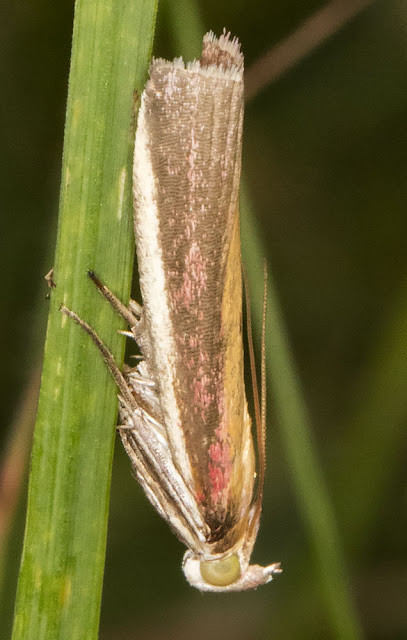 |
| A tiny Sweat Bee, Lasioglossum species, in my back garden, on garden oregano flowers. 12 August 2015. |
I now have a new camera, an EOS 5DS, an amazing thing with a sensor capable of producing detail that only medium format would get to until now. I am still working on making my shots super sharp*, but meanwhile I can get some shots of tiny insects that are much better than I could have managed before. This one is a tiny Sweat Bee dipping its proboscis into a tiny flower.
 |
| Hoverfly, Sphaerophoria species. Female. Hutchinson's Bank, 11 August 2015. |
 |
| Hoverfly, Sphaerophoria species. Male. Hutchinson's Bank, 11 August 2015. |
These are the female and male of a small Sphaerophoria hoverfly - there are a few species than cannot be told apart just from photographs. They are feeding on Ragwort. You can see that their body shapes are quite distinct. With most hoverflies you look for a gap between their compound eyes at the top of their heads; females have the gap, males do not. With Sphaerophorias you do not need to get so close.
I got these two shots to be sharper than the bee.
 |
| Oncocera semirubella. Hutchinson's Bank, 11 August 2015. |
You have to chase these moths around to get any sort of close-up. Like the Crambid grass moths, it flits off when you get close and lands upside down somewhere where it can look like a bit of grass stem. Oncocera semirubella is usually pinker than this specimen, so I suppose this one has been around a bit and has lost some pink scales. But enough remain for a positive identification, and it also has this way of holding its palps pointing upwards, which few moths do.
This is about as sharp as the bee. I do better when I have time to steady the camera.
* What's the best combination of small aperture, speed and ISO for hand-held nature shots? Small apertures give a good depth of field, but you get diffraction effects which make the whole thing less sharp. High ISO allows faster shots, so less motion blur, but more noise, specially in the darker areas. High speed also reduces motion blur but means that unless you are really close, a flash shot will be quite dark, and also relatively noisy. At the moment I am trying out f/20, 1/800, ISO 250 or ISO 1000. Also, I can sometimes sharpen a bit and reduce noise a little bit in Photoshop without compromising the pic. If I were working with static subjects and a tripod I would be trying a very different combination.




No comments:
Post a Comment